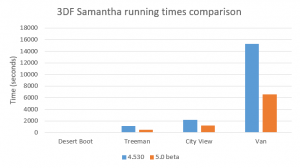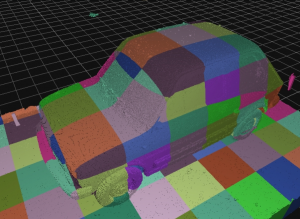With today’s update, we shed some light on some of the most anticipated tech improvements for 3DF Zephyr 5.0 – codename Dragonfruit.
Significant SfM improvements
This is the biggest SfM update ever merged in the production branch of 3DF Samantha. It is very important to note that this update not only makes samantha one of the fastest SfM solution on the market – we are sure you will be suprised and can’t wait to hear your feedback! Did you say data? Data it is!
| 3DF Zephyr 4.530 | 3DF Zephyr 5.0 Beta | |
| Desert Boot | 92/116 0m58s | 93/116 1m5s |
| Treeman | 445/500 19m36s | 445/500 7m46s |
| City View | 884/1098 35m9s | 1098/1098 20m8s |
| Van | 3168/3214 4h14m | 3192/3214 1h48m53s |
We know speed is important – which is why we are very eager to let you try Zephyr 5 with your very own datasets – however accuracy, precision and robustness are always our first priority: you will notice that in most datasets, you will also get more photos oriented.
These datasets have been run with an appropriate default presets, specifically, in order: Close Range, General, Aerial, General.
Out of core and other meshing improvements
Processing data that are too big for your computer memory is a very well known problem in computer programming. Making 3DF Zephyr out of core means that we have optimized how zephyr handles loading and unloading data, as well as how it divides the problem into different smaller problems that are solved and then merged together making the process faster and with a lower memory footprint.
While this approach does not really matter for smaller datasets (for example, the car you see was made with around 200 pictures so any modern computer would very easily be able to process that kind of data) the performances and memory footprint improvements for bigger datasets (think many thousands of pictures) . Other optimizations that benefit this approach are, for example, the fact that now also the photoconsistency can be processed in chunks.
Speed is also improved, although at this time we are not ready for some comparison tests as the final changes are committed in the main branch.
Optimization, optimization, optimization
3DF Zephyr 5.0 is certainly our fastest release ever, and we are sure you are going to be very, very surprised about its speed. Other optimizations in 5.0 are a include a compressed cache (to minimize the disk usage), faster rendering (which means that all stereo mesh, stereo point clouds and stereo textured meshes are rendered faster than before, for a smoother, more pleasant experience even with bigger elements in the 3D workspace).
When is 3DF Zephyr 5.0 going to be released? Soon! Hopefully within 2 weeks we will have a beta stage (as usual, it will be possible to have access to it as soon as we announce it via your 3Dflow Account, which puts the stable release tenatively for mid-june.
For a more detailed status on the completion of the new features, don’t forget to take a look at our development wiki!





